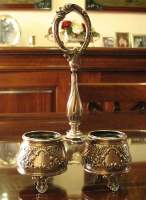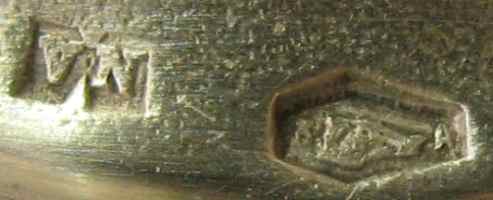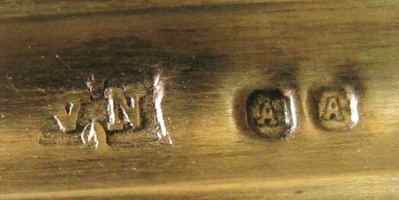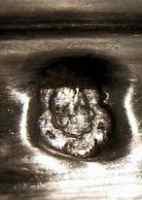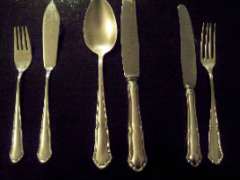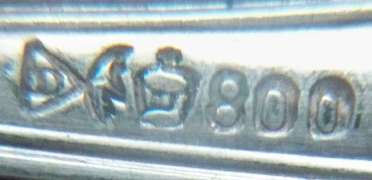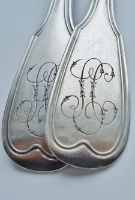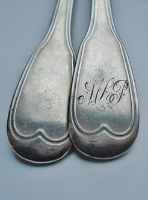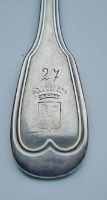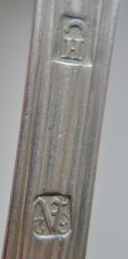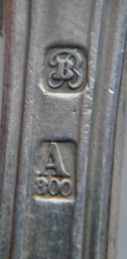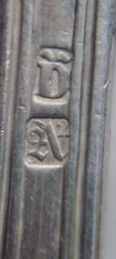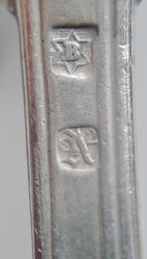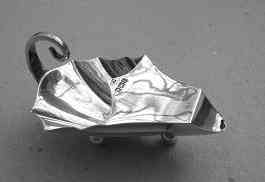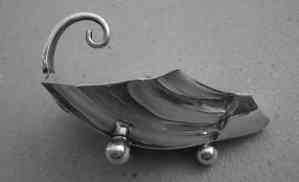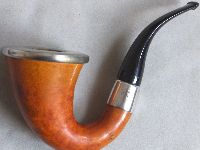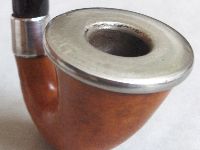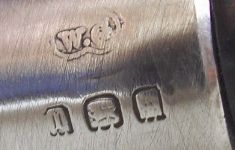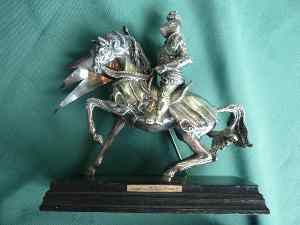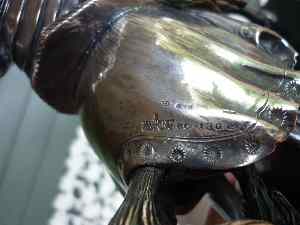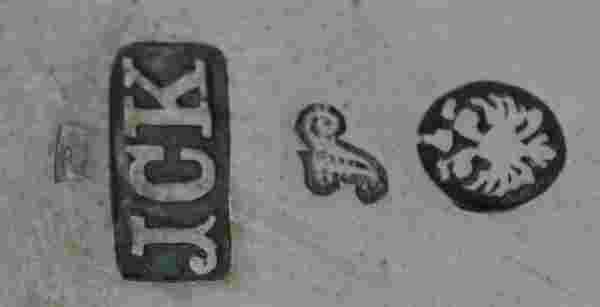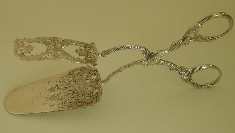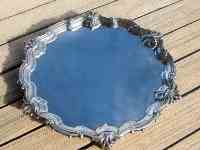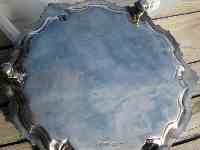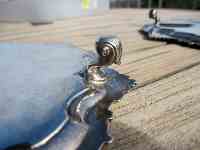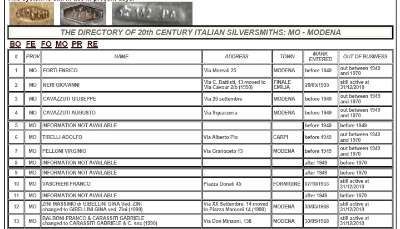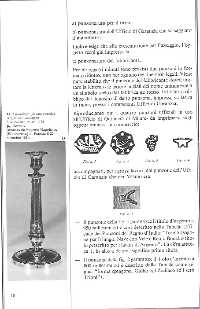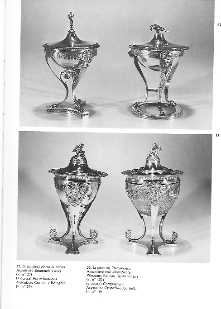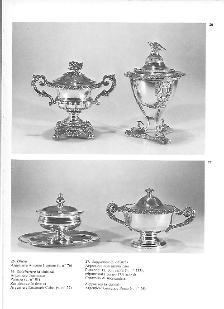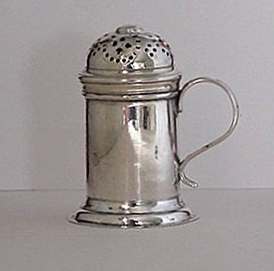
David McKinley presents:
Kitchen Peppers, Bun Peppers and Muffineers:

.....The English sugar caster was invented in the reign
of Charles II and by the end of the 17th century it had
been joined by pairs of smaller versions, made to match,
whose purpose, it is believed, was to dispense pepper
and cayenne. However by the early 18th century quite
different vessels for dispensing pepper had come into
use and, as they did not take the place of the caster
but were used in parallel with it, there is something of
a mystery surrounding them.
These new vessels originally took two forms, the kitchen
pepper and the bun pepper but by the end of the 18th
century these had been joined by a third; the muffineer
(also spelt muffinier). Although these vessels are
casters of a sort, they do not follow the evolutionary
patterns of 18th century casters and their use, as
distinct from casters, has not been definitively
determined by modern historians.....
click here 
|
Welcome to new ASCAS members:
Liz Baird - USA
Nicole Bartlett - Australia
Luigi Fabris - Italy
Francesca Gatti - Italy
Jill Holden - USA
Samuel Hough - USA
John Lewis - England UK
Julia Mackay - Canada
Joseph Mari - USA
Aldo Navoni - Italy
Cor Oostveen - The Netherlands
Bill Poynton - England UK
Alain Renel - France
Andrew Segrest - USA
Monnda Welch - USA
Members' Window # 81
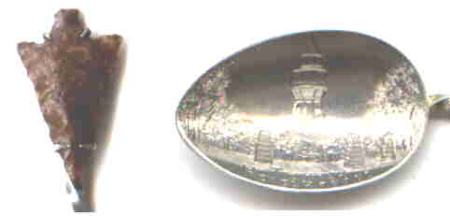
Wayne Bednersh presents:
An Arrowhead Spoon 
Mounted in the finial of this spoon is a brown handmade
obsidian arrowhead.
I do not know if this is an ancient piece or if it were
made contemporaneously with the spoon.
The bowl is a hand engraved picture of the tower at the
Hotel Rafael....
click here 
|
I found this information:
The maker is Victor Nuber, Vienna (active 1891-1905). About the
other questions .....Smaller objects with lower silver content
were marked with marks of a smaller design. For number 3 silver
the head of a whippet was used... and ....For Vienna the letter
A remained in use, now surrounded by an oblong rectangle....
I don't know the meaning of the double "A"
Giorgio Busetto
Ted Orliz writes:
... Enjoy looking at your site, but being a layman, I can never
seem to find the hallmarks I need to find. I recently bought
five large serving spoons with this mark. I would like to find
out the silver content, (BP = Birmingham Plate?) and who made
these and when. I would greatly appreciate any info you wish to
share.
Thank You,
Ted Orliz
I'm sorry but I'm unable to identify the maker of your items.
This is the information I have:
- there is no silver content. Your spoons were made in "white
metal" and not in sterling or solid silver,
- BP means, possibly, British Plate (or Britannia Plate);
- The maker was a manufacturer active in Glasgow and, possibly,
in Sheffield (crown)
- Information about the meaning of figural and literal symbols
are available in my web site at
http://www.silvercollection.it/dictionarysilverplatesymbols.html
- your spoons were made before 1895 c. (after this date the use
of the crown was admitted only in sterling silver pieces).
Any further suggestion by ASCAS members will be welcome
Giorgio Busetto
C.Tarenzi writes:
... I need your help to identify the marks on a German flatware
set I recently bought. Besides the "crescent and crown" there is
a triangle with a "D" inside
C.Tarenzi
It is a pattern, made by "Doublina": Doublina-Besteckfabrik,
A. Wieder Nachf. Hugo Lehn, Stade, N-Elbe (Doublina Cutlery
Factory, A. Wieder Successor Hugo Lehn, from Stade, North Elbe,
Germany).
The pattern is a typical German pattern; in the style of the
1930s to the 1950s. Doublina was one of the little German
cutlery factories, which survived after WWII, but in which year
this pattern was invented, before or after WWII, until yet I
haven't found any notice.
Oskar M. Zurell
Robin Holmes writes:
... here are two pics of a mystery object.....well mystery for
me anyway.
At first glance you would say that this is a gravy/sauce boat or
something similar, but the opening of the mouth is about 1.5mm
by about 3.5mm, and its length is 80mm and height including the
handle is 50mm, so the dimensions are very small.
The item is hallmarked Sheffield 1920.
What is interesting is that the front end is almost beak-like.
My feeling is that there are two possibilities...it was either
used to drip water onto the sugar cube as in the absinth ritual,
or it was a very fancy medicine administering apparatus (though
I see no teeth marks), and I say this latter idea because 1920
was just after the 1918 flu epidemic, and medicating away the
lingering paranoia might have still been in vogue.
I was wondering if anyone else might have seen such an item.
Robin Holmes
Any suggestion will be welcome
Giorgio Busetto
Piero Eduardo writes:
...this is a Calabash pipe with silver complements marked "WG"
or "WC" inside two conjoined circles and 1916 (possibly) London
hallmarks.
I wonder if it is possible to identify the maker.
Thanks in advance for your help.
Piero Eduardo
The silversmith is Walter Gardener GROVES, gold & Silver
worker. This mark was entered in London Assay Office on May 7,
1909.
Giorgio Busetto
Replies to questions
Pietro Fantazzini writes:
... The maker is Fratelli Magrino (Magrino Brothers), (FI
871). They were also the owners of the brand "Maria Cristina
Sterling", which concentrated in 1996 in the " Fabbrica La
Torre" together with the mark Magrino. They used also the marks
FI 1508 and FI 1388.
The firm was specialized in galvanoplastic manufacturing. They
produced several series of decorative items using this
proceeding and other pieces of cast metal.
The most successful series were certainly those of the "knights"
and those of the "sailboats", that were small craftsmanship
masterpieces.
The marks illustrated are (from left) "MAGRINO" (firm's
trademark), "R" (signifying "Riempito" - filled-: in this case
an inappropriate definition as, usually, galvanic pieces were
not filled with synthetic material), the number "180" (meaning
the guaranteed minimum silver weight), "925" in the oval (silver
fineness 925/1000 - sterling-) and "star 871" lacking of FI (the
mark is badly punched).
This piece was presumably manufactured in late 70s, early 80s.
Pietro Fantazzini
Dorothea Burstyn writes:
... About Cor Ostveen's question: this bowl is not "Russian
rococo" but was made by a famous Viennese silver firm
J.C.Klinkosch. The double eagle shows that they were purveyor to
the court.
More info on this firm Waltraud Neuwirth: Wiener Gold-und
Silberschmiede und ihre Punzen 1867-1922, Vienna 1976 and a
monograph about this firm Diether Halama: Die Gold-, Silber- und
Metallwarenfabrik J. C. Klinkosch (1797-1972).
Best, Dorothea
Oskar M. Zurell writes:
This "JCK" mark (type II-1) could maybe an inofficial
maker's marks for Export items, of Gold-, Silber- und
Metallwarenfabrik J.C. Klinkosch, vormals Mayerhofer & Klinkosch«
from Vienna, Austria
But it could be also a fake mark - because for the period of the
early "JCK" (1869-1888) is only officially registered another
type (II-4) of maker's mark.
It was founded in 1797 as Sheffield-Plated factory by the in
Stuhlweissenburg, Hungary 1772 born Stephan Mayerhofer. His
products of quality were appreciated by the members of the 1815
Vienna Congress and by the Court of Austria-Hungary too. There
fore in 1816 was granted to Stephan Mayerhofer the Insignia,
being Austro-Hungary Court Supplier (hence the Double-headed
Eagle-mark).
In 1830, the 1797 born descendant of a brass founder dynasty
from Gdansk and Prague, Carl Klinkosch started his career in
Mayerhofer's factory (then there were busy about 200 workmen);
became partner in 1836.
The next Generation, Stephan Mayerhofer jun. (b. 1819, d. 1889)
and ("JCK") Joseph Carl Klinkosch (b. 1822, master 1843, d.
1888) took over in the middle of the 19th century - in 1869 "JCK"
became owner of the whole.
In 1867 Austria-Hungary started a totally new Assay and Maker's
marks system.
So, if the item is really made by "JCK", then there must be some
more Austro-Hungary marks of that latter time period.
In 1878 "JCK" was knighted; the "knights' helmet" mark was in
Vienna Assay Office registered ten years later, on 11 September
1888, at 10:15 am, number 5633.
The script "V" mark is a Dutch import mark, without warranty of
finenesses, from 1814 on until 30 August 1953.
Sources: Halama, Diether: Die Gold-, Silber- und
Metallwaren-Fabrik J.C. Klinkosch in Wien (1797-1972). Vienna
1997.ISBN 3-9500741-0-4
Neuwirth, Waltraud: Lexikon Wiener Gold- und Silberschmiede und
ihre Punzen - 1867-1922. Two volumes. Vienna 1976. ISBN
3-900282-00-5
Vol. I, p. 295-301 History; Vol. II, p. 333, numb. 1092 (J.C.K.
mark, type II-4).
Kind regards,
Oskar M. Zurell
Karin Sixl-Daniell writes:
... The maker was J C Klinkosch of Vienna. The double headed
eagle shows that this highly respected firm was purveyor to the
court in Vienna. The piece is not an old rococo piece but was
made probably in the last third of the 19th century. The
Klinkosch mark was used from 1869 onwards when the well-known
company Mayerhofer&Klinkosch became "Gold-, Silber- und
Metallwaren-Fabrik Josef Carl Klinkosch" (Stephan Mayerhofer
sold his shares) and the company obtained a royal/imperial
warrant (the double headed eagle also seen on this piece).
Karin
Oskar M. Zurell writes:
...These Asparagus tongs have "J K C" markings, in a contour as like a
slightly deformed Rugby ball.
J. KURZ & Co. was founded in 1907 by the sisters Julie Kurz (b. 1874) and Marie Kurz
(b. 1877).
The address of J. Kurz & Co. was Türkische Gärten 7, Hanau am Main.
This is only one of the marks of J. KURZ & Co. from Hanau, Germany.
The here shown maker's mark is that of their last phase (from maybe end of WWII until
about 1955).
In the documentation source (*) nearly similar tongs are presented as Cake tongs.
(*) Source: (pages 70-73; p. 70 = marks, p. 71 = nearly similar tongs).
Gehrlein, Johanna: Rosen-Bestecke, ISBN 978-3-9813273-0-4 www. rosen-bestecke.de
Oskar M. Zurell
Malcolm Rice writes:
... In reply to the query of Sharon Blasgen about the makers
mark Wb on her salvers of 1755 I suggest she looks at it the
other way up where it might read JM. Please see Grimwade page
116 mark number 1534 for James Morison. Quite often the makers
mark is the opposite way up to the Assay marks.
Kind regards
Malcolm Rice
Karin Sixl-Daniell writes:
...The London salver seems to indeed bear the mark of James
Morison whose mark was entered on 14 May 1740 (for the mark see
Grimwade p. 116 as well as Jackson p. 197. For a short biography
see Grimwade on page 600).
Karin
Maria Entrup-Henemann writes:
...I think, the makers mark is not "Wb", but (upside down) "J.M",
suitable to James Morison (Grimwade Nr. 1534), mark entered in
1740.
Maria
Graham Stapleton writes:
...These are a very agreeable pair of salvers for anybody to
own. Might I suggest that the sponsor’s mark is not Wb, but JM
upside down. To me it looks much like the mark of James Morison,
recorded as a salver-maker; and given the date, potentially they
were some of the last of his output.
I have already learnt that until relatively modern times assay
clerks could be quite inconsistent (occasionally even slapdash
to our perception) in where marks were stamped.
Even in something so regulated as hallmarking, human foibles
will sometimes show through, this is part of the joy of
collecting.
Graham Stapleton
In this column we present a page
obtained from makers' brochures, books, auction catalogs,
advertising or whatever other printed paper, related to silver,
that may be of interest for ASCAS members.
The images will be published at a "low resolution" level and for
private and personal use only
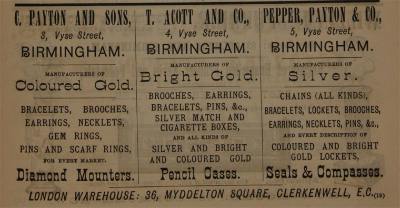
|
This month we present an ancient advertisement
of
C.PAYTON AND SONS
T.ACOTT AND CO
PEPPER, PAYTON & CO
The business was founded by Charles Payton
(c. 1820) and carried on (in the 1890s) by Henry
Payton, George John Payton and Joseph F. Pepper.
The firm was active at 3, 4 and 5 Vyse Street,
Birmingham, with London Warehouse at 36 Myddelton
Square, Clerkenwell.
In 1898 the firm was acquired by Payton, Pepper &
Sons Ltd.
|
"A WORD per MONTH"
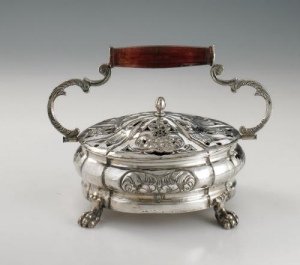
|
HAND WARMER
BED WARMER
When central heating was not available, besides
stove and fireplace, another heating item was used in
ancient times: the warmer (or brazier).
It was a container in metal, terracotta or ceramic
filled with embers and warm ash used as personal heating
support and bed warming.....
more
|
"A SILVERSMITH per MONTH"
|
|
ITALIAN SILVERSMITHS
OF THE 20th CENTURY
MAKER'S MARKS DIRECTORY
This month, ASCAS does not
present a single company or a silversmiths' dynasty.
The column of this month is dedicated to a new
initiative having the objective to create a wide
historical list of ITALIAN SILVERSMITHS OF THE 20th
CENTURY.
This project has just started and will be completed as
soon as possible.
Thanks to the contributions of Andrea Menarini and Pietro
Fantazzini, the site www.silvercollection.it starts the
publication of the lists, sorted by province, of most of
the silversmiths who registered their mark in Italy in
the period 1935-1970.
This is a demanding task, but in this way, when our work
will be completed, historical lists of Italian
Silversmiths will be available, never published before
in so complete form.
Any further information and addition to these lists from
owners of ancient Annuari Orafi (Jewelry Directory) will
be highly appreciated.
more
|
"A BOOK ON MY SHELF"
In this column we present books, new
or ancient, dealing with silver in all its aspects (history,
marks, oddities...). This isn't a "book review" but only a fair
presentation of some useful "tools" that anyone may have in the
shelf of his bookcase.
ASCAS members are invited to contribute to this column
(click to enlarge images)
The "book on my shelf" of this month presents:
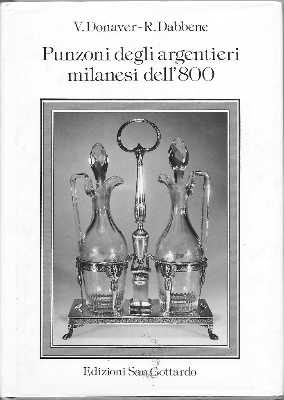
|
PUNZONI DEGLI ARGENTIERI
MILANESI DELL'800
by
V. Donaver - R. Dabbene
Edizioni San Gottardo
Milano
1985
(MARKS OF MILANO'S SILVERSMITHS OF THE 1800s:
the text is in Italian)
|
"A CREST per MONTH"
In this column we present images and
descriptions of Crests and Mottoes of British, Irish and
Scottish families as engraved on silver items.
M'NAB
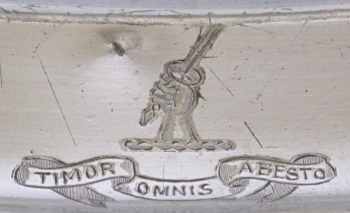
|
A Scottish family
A dexter hand with a sword and the motto Timor omnes
abesto (Let fear be far from all)
The crest was found in a silver plate dish made by
Frederick Ellis Timm & Co - Sheffield (active c.
1860-1918)
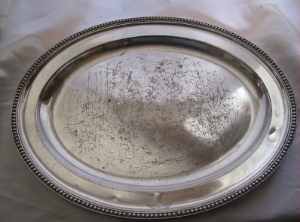

|
Closing our February 2011 edition of ASCAS
Newsletter I hope you have appreciated its content.
Your comments, suggestions and advice will be of great help.
My thanks to Wayne Bednersh,
Pierre Bertrand, Dorothea Burstyn, Jayne Dye, Piero Eduardo, Maria
Entrup-Henemann, Pietro Fantazzini, Robin Holmes, David
McKinley, Claudio Morelli, Ted Orliz, Malcolm Rice, Karin
Sixl-Daniell, Graham Stapleton, C.Tarenzi, Oskar M. Zurell for
their invaluable contributions.
Giorgio Busetto
Secretary
DISCLAIMER AND PRIVACY POLICY
ASCAS is a community of people having a common
interest in antique silver.
It is a non-profit association without commercial links.
Membership is open to whomever has a true interest in
this subject matter.
ASCAS has no real property and no fees are requested nor
accepted from members.
ASCAS keeps in touch with its members only through
periodical newsletters, e-mails and web-site updating
and ignores and is not responsible for any other
activity pursued by its members.
Likewise, ASCAS is not responsible for opinions,
evaluation and images displayed, and in any form
published or supplied for publication, by its members
who, in any case, maintain the property of their works
and assure the respect of national and international
legislation about Intellectual Property.
ASCAS does not have the full addresses of its members (only
town, country and e-mail address are requested for
membership).
ASCAS handles and protects with care its members' e-mail
addresses, will not disclose the addresses to third
parties, will use this information only to reply to
requests received from members and for communications
strictly related to its activity.
These rules are expressly accepted by submitting the
membership request.
|
|
 newsletter
# 81 February 2011
newsletter
# 81 February 2011







